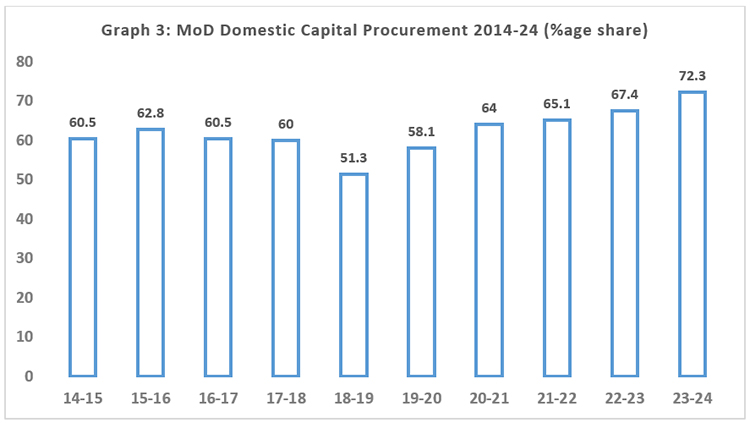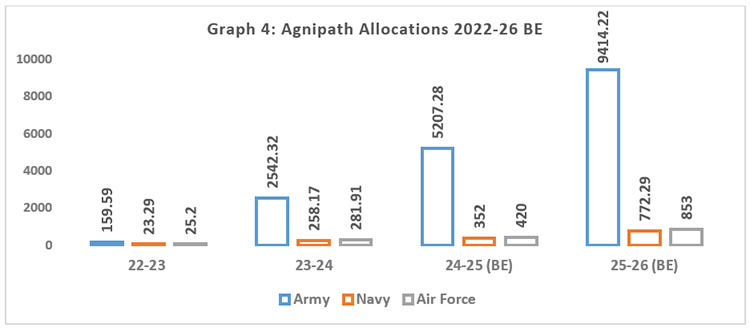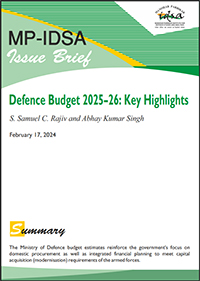Defence Budget 2025–26: Key Highlights
- February 17, 2025 |
- Issue Brief
Summary
The Ministry of Defence budget estimates reinforce the government’s focus on domestic procurement as well as integrated financial planning to meet capital acquisition (modernisation) requirements of the armed forces.
Finance Minister Nirmala Sitharaman presented the Union Budget on 1 February 2025. The budget estimates (BE) for the Ministry of Defence (MoD) stood at Rs 681,210.27 crore, an increase of 9.5 per cent from 2024–25 BE of Rs 621,940.85 crore.1 The focus of the government on integrated financial planning to meet capital acquisition (modernisation) requirements of the armed forces, domestic procurement, defence research and development (R&D), border and maritime security, and welfare of soldiers and ex-servicemen (ESM) continues in the MoD budget estimates. The following sections will place in context key highlights relating to the capital and revenue allocations as part of the four demands of the MoD—MoD Civil, Defence Services Revenue, Capital Outlay on Defence Services and Defence Pensions. Table 1 lists the key MoD budget estimates for 2025–26, in comparison to 2024–25 BE.
Table 1. Ministry of Defence Budget Estimates: 2024–25 BE and 2025–26 BE (in crore)
| 2024–25 BE | 2025–26 BE | %age Change from 2024–25 BE | |
| MoD Civil | 25,963.18 | 28,682.97 | 10.47 |
| Defence Services Revenue | 282,772.67 | 311,732.3 | 10.24 |
| Capital Outlay on Defence Services | 172,000 | 180,000 | 4.65 |
| Defence Pensions | 141,205 | 160,795 | 13.87 |
| Total Defence Budget | 621,940.85 | 681,210.27 | 9.53 |
| Pay and Allowances
(Uniformed Personnel) |
146,083.6 | 145,749.24 | -0.23 |
| DRDO | 23,855.61 | 26,816.82 | 12.41 |
| Border Roads Development Board (Capital) | 6,500 | 7,134.5 | 9.76 |
| Coast Guard | 7,651.8 | 9,676.7 | 26.46 |
| ECHS | 6,968 | 8,317 | 19.36 |
| Agnipath | 5,979.28 | 11,039.51 | 84.63 |
Source: “Union Budget Documents 2025-26”, Ministry of Finance, Government of India.
Capital Allocations
The Capital Outlay on Defence Services, at Rs 180,000 crore—Rs 8,000 crore more than 2024–25 BE—shows a 4.65 per cent growth. The MoD notes that Rs 148,722.8 crore (or 82.6 per cent of total capital outlay) is the modernisation budget to be spent on Capital Acquisition. As per MoD, these funds will cater to the acquisition of assets such as ‘Long Endurance Remotely Piloted Aircraft of High and Medium altitude, stage payment of Deck-based Aircraft’ as well as ‘next generation submarines/ships/platforms’. Rs 31,277.20 crore has been earmarked for ‘capital expenditure on Research & Development and creation of infrastructural assets’, which the MoD also refers to as Capital (Other Than Acquisition) or Other Than Capital Acquisition (OTCA).2
The modernisation budget includes budget heads relating to Aircraft and Aero engines, Heavy and Medium Vehicles, Other Equipment, Joint Staff, Procurement of Rolling Stock, Naval Fleet, Naval Dockyard/Projects and Special Projects. The budget estimates under these heads in 2025–26 BE amounts to Rs 148,838.9 crore, as against Rs 140,870.91 crore in 2024–25 BE and Rs 132,089 crore in 2024–25 Revised Estimates (RE).3 The increase in capital outlay on defence services in 2025–26 BE from 2024–25 BE (Rs 7,967.9 crore), therefore, is roughly equivalent to the amount not spent under modernisation heads from BE to RE stage (Rs 8,782 crore).
In 2024–25 BE, demands relating to modernisation heads of each of the services were consolidated under similar items such as Heavy and Medium Vehicles, Land, Aircraft and Aero Engines, among others. This was to bring flexibility in financial management, expedite decision making and ensure that funds could be re-appropriated among the three services based on inter se priority.4 This was a key reform in the budgetary process to conform to the extant capability development and integrated perspective planning processes. This practice continues in this year’s BE as well and reinforces the integrated approach of defence procurement. These consolidated allocations can aid capability building for armed forces as a whole (for instance, in procurement of unmanned aerial vehicles) rather than procurement based on single service demands.
Given the consolidated heads of the capital outlay (modernisation) budget, service-specific amounts for each item is not available in the budget document. The MoD, in its presentation to the Standing Committee on Defence (SCOD) in December 2024, however, provided the overall service-specific allocations under the modernisation heads (as against allocations for each item for each service) in 2024–25 BE. The SCOD was informed that out of Rs 140,691.24 crore modernisation budget in 2024–25 BE, the Army accounted for Rs 27,421 crore (19.5 per cent), the Navy (minus the Joint Staff) for Rs 57,950 crore (41 per cent) and the Air Force for Rs 54,570 crore (39 per cent).5 Graph 1 depicts the growth in the capital acquisition (modernisation) budget from 2016–17 to 2025–26 BE. It has more than doubled from Rs 69,831.14 crore to Rs 148,838.9 crore in 2025–26 BE, a cumulative annual growth rate (CAGR) of 7.8 per cent.

Source: “Union Budget”, Various Years, Ministry of Finance, Government of India.
Note 1: The graph shows allocations in 2016–24 (Actuals) and 2024–26 (BE) for Aircraft and Aero engines, Heavy and Medium Vehicles, Other Equipment—Army, Navy Air Force; Rolling Stock (Army); Joint Staff (Navy); Naval Fleet, Naval Dockyards/Projects, and Special Projects (Air Force). These correspond to the consolidated items under modernisation heads as shown from 2024–25 BE onwards.
Note 2: Budget documents available online do not have segregated data for capital acquisition and capital (other than acquisition) for demand heads such as Joint Staff (Navy). This data is in Defence Services Estimates (various years), a document which is not available online. Hence, there could be minor difference in the amounts shown in Graph 1 from corresponding data which may be available in MoD press releases.
Graph 2 shows the capital acquisition (modernisation) budget for the three services, other than Joint Staff (Navy), from 2015–25 BE. The Army’s capital acquisition budget showed a growth of 90 per cent from 2015–25 BE (from Rs 14,396.7 crore to Rs 27,421.3 crore) while the Air Force budget showed a growth of 86 per cent (from Rs 29,337.4 crore to Rs 54,570 crore). The Navy’s modernisation budget showed a growth of 215 per cent from Rs 18,414.8 crore to Rs 57.950 crore during the same time period. The Navy’s capital acquisition (modernisation) budget increased dramatically after 2019–20 (perhaps due to Scorpene-class submarine inductions) while the Air Force budget dipped in 2021–23. The MoD’s capital procurement budget accounted for nearly 19 per cent of the central government’s capital expenditure from 2019–24 (Rs 572,410 crore out of Rs 3,043,448 crore).6

Source: “Union Budget”, Various Years, Ministry of Finance, Government of India.
Note: The data shown includes modernisation budget heads for three services apart from Joint Staff (Navy) from 2015–24 (Actuals) and 2024–25 BE.
The 2025–26 BE further reinforce the government’s conscious efforts to strengthen the domestic defence industrial base. In Financial Year 2025–26, three-fourths of the modernisation budget—Rs 111,544.83 crore—is for procurement through domestic sources. About 25 per cent of this, i.e., Rs 27,886.21 crore, is for procurement from the domestic private industry. The government in 2020–21 decided to bifurcate the MoD’s capital acquisition budget, mandating a specific portion to be spent on domestic procurement. Accordingly, in 2020–21, Rs 52,000 crore, which was 40 per cent of the modernisation budget, was allotted to be spent on procurement from domestic sources. This went up to 58 per cent of the modernisation budget (Rs 78,335 crore) in 2021–22 BE, 68 per cent (Rs 84,598 crore) in 2022–23 BE, 75 per cent (Rs 99,223 crore) in 2023–24 BE and 75 per cent (Rs 105,518 crore) in 2024–25 BE.
Therefore, a total of Rs 419,674 crore was the allocation in the MoD budgets from 2020–25 to be spent on domestic procurement. The actual amount MoD spent on domestic procurement from 2020–21 to 2023–24 stood at Rs 322,641.4 crore, Rs 8,485.4 crore more than the budget estimates for those years.7 The percentage share of MoD’s domestic capital procurement is shown in Graph 3. From 2014–24, the MoD cumulatively spent Rs 579,123.34 crore on domestic procurement (63 per cent), as against Rs 336,980.7 crore on foreign procurement (37 per cent), out of total capital procurement of Rs 916,032.1 crore.8 Further, from 2021–24, the Air Force accounted for 53.8 per cent of total foreign capital procurement, followed by the Navy at 31.5 per cent and the Army at 14.7 per cent.9

Source: SCOD, “Capital Outlay on Defence Services, Procurement Policy and Defence Planning, Demand No. 21, Third Report”, Standing Committee on Defence (SCOD), Eighteenth Lok Sabha, Lok Sabha Secretariat, December 2024, p. 23.
The Coast Guard Capital procurement budget has also seen a significant jump in 2025–26 BE over 2024–25 BE. It stands at Rs 5,000 crore, an increase of 43 per cent or Rs 1,500 crore. The total allocations for the Coast Guard stands at Rs 9,676.7 crore. The increase in capital budget for the Coast Guard, the MoD notes, is to provide for the ‘acquisition of Advanced Light Helicopters (ALH), Dornier Aircraft, Fast Patrol Vessels (FPVs), Training Ships, Interceptor Boats’ among other equipment.10 By 2030, the Indian Coast Guard (ICG) is expected to have 200 surface platforms and 100 aircraft. It currently has 151 ships and 76 aircraft.11 The increased allocations will help the ICG deliver on its varied roles relating to search and rescue, disaster response, combating illegal activities at sea and other emerging maritime threats.
While the Coast Guard budget has seen a CAGR of 8.6 per cent from 2016, the capital budget of the Border Roads Development Board (BRDB) has seen a CAGR of 10.6 per cent, growing from Rs 2,589.55 crore in 2016–17 to Rs 7,134.5 crore in 2025–26 BE. This is expected to cater to the building of key roads, tunnels and bridges in Jammu and Kashmir, Arunachal Pradesh and Rajasthan. The capital allocations for the DRDO have risen from Rs 13,208 crore in 2024–25 BE to Rs 14,923.82 crore, an increase of 13 per cent.
Revenue Allocations
MoD statements on the budget in recent years have also highlighted operational and sustenance requirements of the armed forces. The latest statement notes that higher amounts for operational and sustenance preparedness of the armed forces have been allocated since FY 2022–23 to cater for the requirement of forces in the border areas, deployment of ships and increase in flying hours of aircraft. Rs 114,415.5 crore out of the total Defence Services Revenue BE of Rs 311,732.3 crore (36.7 per cent) has been allocated in 2025–26 BE to ‘facilitate procurement of Ration, Fuel, Ordnance Stores and maintenance/repair of equipment’.12 The average annual percentage of the budget heads that make up Transportation and Stores from 2016–26 BE is 21.7 per cent of the total defence services revenue budget. It increased to 24 per cent in 2022–23 and in 2025–26 BE, it stands at 23.4 per cent.
Pay and Allowances (of uniformed personnel as well as civilians in the three Services and the DRDO along with the allocations for Agnipath) constitutes 57.4 per cent of the defence services revenue budget in 2025–26 BE, as against 61.2 per cent in 2024–25 BE, 57.2 per cent in 2023–24 and 58.7 per cent in 2022–23. Prior to the introduction of the Agnipath scheme in June 2022, MoD Pay and Allowances as a percentage of defence services revenue budget stood at 61.4 per cent in 2021–22. While Pay and Allowances for Uniformed Personnel in 2025–26 BE has seen a dip of Rs 334 crore from 2024–25 BE, there is a significant jump of 85 per cent in allocations for Agnipath, from Rs 5,979 crore to Rs 11,039.51 crore, an increase of Rs 5,060 crore.

Source: “Union Budget Documents 2025-26”, Ministry of Finance, Government of India.
There has been a 20 per cent growth in the allocations for the ECHS in 2025–26 BE over 2024–25 BE. Allocations for the ECHS have seen a CAGR of 11.5 per cent over 2016–26 BE. The ECHS was launched in April 2003 and provides healthcare support to ex-servicemen (ESM) pensioners and their dependents in service hospitals as well as in civil/private hospitals empanelled with the ECHS. As on 31 December 2023, the number of ex-servicemen in the country was over 27 lakhs.13 The ECHS has a beneficiary base of over 55 lakhs (ESM and their dependents) and over 3,000 empanelled hospitals.
Defence Pensions, meanwhile, saw allocations rise to Rs 160,795 crore, from Rs 141,205 in 2024–25 BE, a growth of nearly 14 per cent. The MoD in its press release on the budget stated that this growth in defence pensions will account for inflationary trends and also noted that the third revision of the One Rank One Pension (OROP) came into effect in July 2024.14 The defence pension budget saw a rise of nearly 33 per cent in 2014–15, 46 per cent in 2016–17 and 31 per cent in 2022–23 due to disbursement of OROP arrears.
Conclusion
The MoD budget, therefore, further strengthens the key focus areas of the government in terms of capacity and capability building of the armed forces and the domestic defence industrial base. Apart from the allocations to the MoD, some of the other significant decisions relating to strengthening the shipbuilding and port infrastructure, Rs 20,000 crore to implement private sector led R&D and innovation, among others, are expected to strengthen strategic and dual-use sectors such as ship building and R&D, and give a fillip to the micro, medium and small enterprises (MSMEs), which are increasingly playing a crucial role in the defence industrial base.
Views expressed are of the author and do not necessarily reflect the views of the Manohar Parrikar IDSA or of the Government of India.
- 1. “Union Budget Documents 2025-26”, Ministry of Finance, Government of India.
- 2. “A Record Over Rs 6.81 lakh crore Allocated in Union Budget 2025-26 for MoD, an Increase of 9.53% from Current Financial Year”, Press Information Bureau, Ministry of Defence, Government of India, 1 February 2025.
- 3. The MoD statement on the budget notes that the budget estimates for modernisation is Rs 148,722.8 crore. The sum total of budget heads that constitute the modernisation basket in the budget document stands at Rs 148,838.9 crore. The difference could relate to OTCA BE of Joint Staff, data of which will be in Defence Services Estimates (not available online).
- 4. “Record Over Rs 6.21 lakh crore Allocation to Ministry of Defence in Interim Union Budget 2024-25; 4.72% more than FY 2023-24”, Press Information Bureau, Ministry of Defence, Government of India, 1 February 2024.
- 5. “Capital Outlay on Defence Services, Procurement Policy and Defence Planning, Demand No. 21, Third Report”, Standing Committee on Defence (SCOD), Eighteenth Lok Sabha, Lok Sabha Secretariat, December 2024, pp. 3–4.
- 6. Central government capital expenditure data for 2019–24 is taken from SCOD, “Capital Outlay on Defence Services, Procurement Policy and Defence Planning, Demand No. 21, Third Report’, pp. 9–10.
- 7. “Capital Outlay on Defence Services, Procurement Policy and Defence Planning, Demand No. 21, Third Report”, p. 23.
- 8. Ibid.
- 9. Ibid., p. 25.
- 10. “A Record Over Rs 6.81 lakh crore Allocated in Union Budget 2025-26 for MoD, an Increase of 9.53% from Current Financial Year”, no. 2.
- 11. “Indian Coast Guard Celebrates its 49th Raising Day”, Press Information Bureau, Ministry of Defence, Government of India, 1 February 2025.
- 12. “A Record Over Rs 6.81 lakh crore Allocated in Union Budget 2025-26 for MoD, an Increase of 9.53% from Current Financial Year”, no. 2.
- 13. “Pension and Job Opportunities for Ex-Servicemen”, Press Information Bureau, Ministry of Defence, Government of India, 20 December 2024.
- 14. “A Record Over Rs 6.81 lakh crore Allocated in Union Budget 2025-26 for MoD, an Increase of 9.53% from Current Financial Year”, no. 2.






